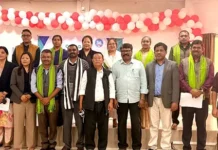[ Nyatum Doke ]
No one will disagree with the fact that Arunachal is changing and moving ahead. I am sure five or ten years back no one would have imagined even in their wildest dream about the idea of an international summit in a small town like Namsai. Today, it’s a reality; to be specific Namsai district is probably one of the most happening and fast-growing districts in Arunachal Pradesh. In addition to the sobriquet ‘Land of Pagodas’, Namsai will soon be called the ‘Land of Conference, Summits and Conclave: The Conference Town of Arunachal’.
As I reached the Dirak gate to attend the C20 conclave in Namsai, I was astonished to see the intricately and beautifully designed welcome gate. Then, as I moved further, it was fascinating to see the entire stretch of Namsai, festooned and decorated with colourful flags, placards and banners – hanging, flying and greeting – ‘Welcome to C20 conclave’.
As our CM Pema Khandu said, ”C20 summit serves as an exceptional platform for dialogue, knowledge-sharing, and collaboration among civil society organisations from around the world,” which aims to promote “social and economic development with the vision that no one should be left behind.’
C20 is a people-to-people platform of G20 group for generating “seed ideas” through effective deliberations, a keynote speaker S Gurumurthy said.
I agree with Legislative Assembly Speaker PD Sona when he said that the theme of the C20 conclave seminar, ‘Diversity, inclusion and mutual respect’, is most relevant for a state like Arunachal, which is a mosaic of different cultures, languages etc, living in harmony and brotherhood.
The message from the C20 conclave was eloquent and clear; it dealt with revitalising culture, respecting indigenous traditions, balancing development and environment, and relooking at the ethnocentric and anthropocentric approach to ensure that there is ‘one world’, one life which would include all sentient beings. The main crux of all the deliberation was to ensure that no one is left behind, and to create a harmonious society in place of a homogenous society by encouraging and accepting differences. So many questions popped up and lingered in my head after the rigorous four plenary sessions in two days. I believe the C20 conclave served its purpose in the sense that it led to sprouting of thought and questions within the minds of the people like me.
As the panellists were continuously deliberating the importance of diversity and mutual respect which will result in a harmonious and peaceful society, I was wondering what should be the path that should be taken to ensure mutual respect when intolerance is at the peak. There was no discussion on the ‘path’.
They said that “there is a need to move from ‘I’ to ‘we’ as a path to cosmopolitanism or vasudeva kutumbakam. Isn’t it dangerous to emphasise too much on ‘we’ or ‘one’? Won’t it result in eroding the ‘I’ or the individual culture, which is the very virtue of diversity and mutual respect? While some were speaking about the end of globalisation and its ill-impact on the society, wasn’t the summit like G20 or the focus one oneness and one world a result of globalisation-led increased connectivity.
One panellist classified culture into ‘desert culture and river culture’ and stated that desert culture, like desert ecosystem, is devoid of diversity; whereas river culture with rishis and munis is better and richer. I am curious as to which culture can be regarded as a desert culture? Can any culture be devoid of diversity? Are deserts devoid of any diversity? Also, aren’t such artificial classifications antithetical to the very core of cosmopolitanism that we are trying to promote and embrace?
Apart from these, there are some questions which some skeptical people raise: why is such a big event involving so much resource important? What is the outcome? First of all, Arunachal Pradesh, being considered as a venue to host such events itself can be counted as one of the biggest achievements of the present government led by CM Pema Khandu.
Also, such events may not have immediate tangible results, but such events broaden the horizons of our thought process from local to global. It provides much-needed experience and confidence for taking up bigger responsibilities (even at the international level). Then, Arunachal, which is bestowed with rich traditions, cultures, nature and heritage, will get an opportunity to showcase its potential to the global world.
Therefore, such events have both intrinsic as well as instrumental values for the state. In the long run, it will come handy for the state. CM Pema Khandu very aptly appealed to all the delegates to “be an ambassador of Arunachal, a place of true diversity, inclusion and mutual respect.”
Namsai is truly becoming an epitome for other districts to emulate; a small town capable of accommodating such a huge national and international gathering without any hiccups is praiseworthy. The district administration headed by DC CR Khampa deserves appreciation. Then the people of Namsai, who are ever ready to march hand in hand with the challenges and opportunities, need special appreciation. I was surprised to see the number of homestays and the hospitality of the people during the last literature festival.
Lastly, as Padma Shri awardee Nivedita Bhideji opined, human progress is not linear but spiral; we need to balance our outer development with inner development, otherwise there will be confusion. It’s not just tolerance but the aspiration for harmony which is needed in the society that lets accept differences and respect and accommodate diversity. Then it must be understood that there is a very thin line between ‘oneness’ and ‘homogenous’. If we do not take a nimble-footed approach, we may fall into the other side of the fence, which we are actually trying to avoid: falling into the hubris against which Sherpa C20 India Vijay Nambiar cautioned the world about (The writer is DIPRO, Longding)


